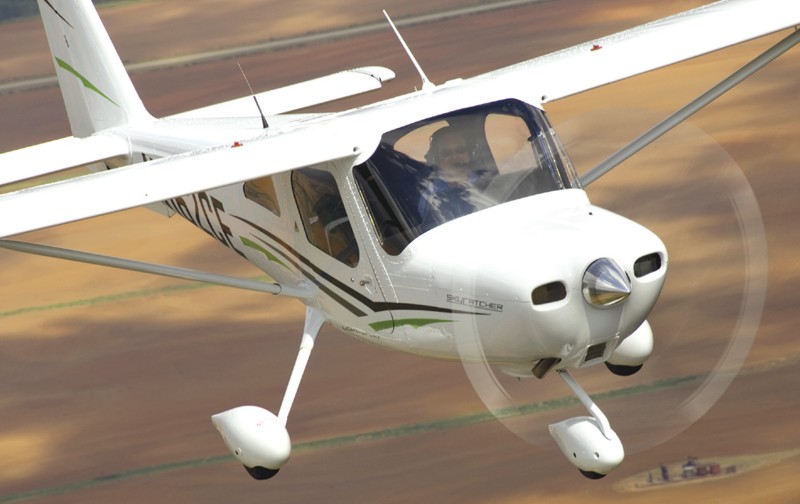
photo courtesy Cessna Aircraft
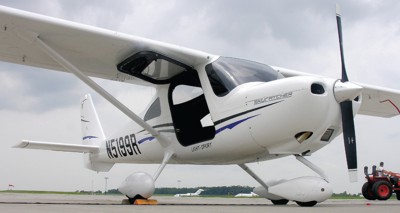
LITTLE GIANT – The littlest aircraft from the biggest company, the Skycatcher is true to its roots
while still setting a new pathway for Cessna Aircraft
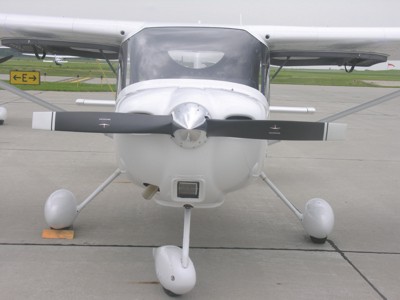
TWO BLADES – Cessna stuck with a 2-blade prop throughout development. Next, they will use a composite
prop, which is expected to be 10 pounds lighter.
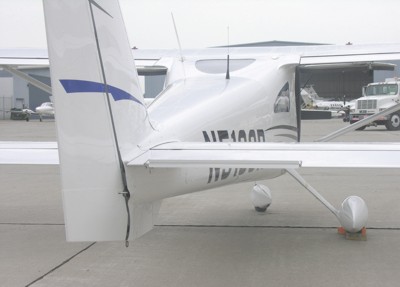
BIG RUDDER – After their thorough spin trials, Cessna added the ventral fin on the lower side of the
fuselage and enlarged the rudder to match.
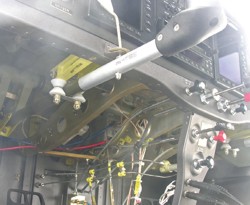
STICK? YOKE? – It doesn’t move just like a joystick
or a control yoke, but it worked well and never got
in the way of my legs.

A LITTLE ATTITUDE – Skycatcher landings are best done with an attitude landing technique using only
a modest backstick pull to roll the wheels onto the runway. photo courtesy Cessna Aircraft

HANG TIME – The Skycatcher enjoyed staying aloft, and retained good roll authority during slow-flight
maneuvering and even at near-stall speeds. photo courtesy Cessna Aircraft

LITTLE LADDER – High-wing airplanes of many
types require a little boost for refueling as Cessna
check-out pilot Kirby Ortega demonstrates.

SIMPLE RELIABILITY – Cessna improved on the
venerable sight tube by adding positions for inflight
and on the ground. Also note the nearby stall
horn and air inlet.

STABLE FLYING – The Skycatcher stalls a few knots slower
than either the Cessna 150 or 152, despite having a much
smaller wing. photo courtesy Cessna Aircraft

SIMILAR IDEAS – The Skycatcher’s tail compares to a Flight
Design CTLS parked nearby. Both use a ventral fin.

DAMPENER STRIPS – Gurney flaps or strips (developed by
racecar driver Dan Gurney) dampen pitch movements according
to some who have flown the Skycatcher.

NO ROUND? – Hey! Where are the round gauges? The
Skycatcher went fully digital as standard instrumentation.
Dual screens as flown are an option.

CHECK PILOT – Kirby Ortega showed Dan Johnson around the Skycatcher. At AirVenture
2010, this talented pilot also gave Corvalis and Mustang jet check-outs in addition to the
Skycatcher.

VOLUMINOUS BAGGAGE – If you need to carry bulky items weighing no more than 50 pounds
total, this large baggage will do it. Note the netting at the rear.

ALL-LED – All Cessna lighting is LED, known for its long
life and good brightness.
Honestly, I never thought I’d see this day arrive. As I started work
on a Cessna aircraft review for the pages of Light Sport and
Ultralight Flying magazine, I thought, We’ve come a long way.
When this publication was started 35 years ago, it was titled Glider Rider
and it featured hang gliders. Coverage then expanded to include powered
ultralights, and now light-sport aircraft (LSA) are included in the mix.
This month I’ve written a pilot report on Cessna Aircraft’s Skycatcher
LSA, the first Cessna in modern memory not built to FAR Part 23 standards,
that is, not type-certified by the U.S. government. Some may say ultralights
“grew up” to become light-sports. But I say that Cessna has moved
(returned?) to very light aircraft designs. I consider their arrival significant.
It isn’t simply that you can buy a brand-new Cessna for $112,500 (more on
the price later). The more important point to Light Sport and Ultralight
Flying readers is that the Skycatcher flies similarly to what light aircraft
enthusiasts fly. Probably no one is surprised to hear Cessna can create an
airplane that flies well, but that it also behaves and performs like, well, like
a very light aircraft – this does surprise, a little anyway. Even after building
hundreds of jets per year, Cessna hasn’t forgotten how to design a light
plane.
BUILT LIKE A CESSNA?
Cessna 150s maxed out at 1,600 pounds gross weight while the somewhat more
sophisticated 152 model ramped up to 1,675 pounds. Respectively, these are 280
to 355 pounds more than the Skycatcher. Weighing 21-27% less brings a benefit
in the Skycatcher’s performance categories like takeoff distance or climb. Aloft, a
Light Sport and Ultralight Flying Pilot’s Report
lighter weight can mean livelier handling.
Adding to the Skycatcher’s weight advantage is a smaller wing. The 150/152
wing was 160 square feet while the Skycatcher has only 120 square feet, about
25% less, commensurate with the weight loss, yet stall is even lower on the newer
design.
Skycatcher serial number 7 has 460 pounds of useful load, according to my highly
qualified check-out pilot, Kirby Ortega. However, he noted, when a change is
made from the current metal McCauley prop to a composite McCauley with nickle
leading edges, Cessna will save 12 pounds. Down here in very light aircraft
land, that’s no small sum to save.
Ortega compared the Skycatcher useful load to a 1985 model 152 (near the end
of the production run), which had a 500-pound useful load with only a single
comm radio installed. In comparison, Skycatcher #7 had a radio, transponder, and
dual glass screens.
Cessna has built more than 100,000 high-wing, strutted aircraft,
so naturally the Skycatcher retains the look. Showing improved
user friendliness, the wing strut is now behind the doors, which
helps entry significantly. The strut location also allows gull-wing
doors unlike any Cessna I’ve ever seen, further aiding entry and
egress.
You won’t see a single round gauge in the Skycatcher as it gets
all information from the standard Garmin G300. Most buyers will
likely opt for the two-screen setup as one can show all info should
the other fail.
Unlike most piston Cessnas, the Skycatcher uses electric trim
and not the familiar wheel arrangement. This may be uncommon
for Cessna 172/182 drivers, but it’s familiar to many very light aircraft
enthusiasts.
Cessna 150s had 2-blade props and so does the Skycatcher. The
company started with the 80-hp Rotax 912 on its proof of concept
LSA, but after the legion of Cessna mechanics and flight schools
weighed in, engineers switched to the 100-hp Continental O-200D,
which came at a 35-pound weight penalty to the Austrian engine.
For Cessna outlets, maintenance familiarity won over useful load.
In another move sure to be appreciated by busy flight schools,
right and left flaps and ailerons can be exchanged with the exception of a trim tab
that may be added to one aileron, and that is a pop rivet change that a maintenance
shop could do quickly.
Lots of interesting thinking went into the Skycatcher. Ortega referred to a
“house” battery, which is used to start the engine. A secondary battery provides
about 10 minutes of power to the G300. Cessna uses the two-battery method to
avoid wearing down the G300 power supply during a long engine-cranking exercise.
When preflighting a Skycatcher, you can simply pull the flaps down and carefully
inspect some internal components. Springs return them to their previous
position.
ROOMY CABIN
The Skycatcher may be on the smaller size for cabins among all LSA (at 43.6
inches), yet it is more than 4 inches wider than the company’s 4-seat Cessna 172
(at 39.5 inches).
The cabin is spare with a painted interior and shows some plumbing and
wiring. But she sports surprisingly comfortable seats that tilt forward for baggage
access. The seats don’t adjust otherwise, but a big knob on the floor – one you can
reach in flight – allows adjustable pedals. I checked and they move far enough to
accommodate people of much different heights. Using fixed-position seats allows
larger seats without adding weight.
For entry, Ortega advised inserting my inside leg first, then sitting down and
drawing in my other leg. One thing you won’t battle is a joystick in your way.
We flew for an hour and 10 minutes, and I noticed no discomfort from the seats.
The seats are firm, but I found they offered good support and I am normally
rather hard to please in this regard.
You can see laterally out of the Skycatcher better
than in a Cessna 150/152 as you don’t need to
lower your head as much if you’re tall.
The Skycatcher provides storage areas on
either side of the center console. When seats fold
forward, you can store some flat items underneath.
Plus, zippered pockets are provided on
each door.
The baggage area is huge and holds 50 pounds
(weight and balance permitting). The aft end of
the baggage area has a lightweight and removable
fabric panel allowing access to the tail boom.
As we taxied out, I found a little struggle to
keep taxi steering precise by using brakes and a
castoring nosewheel. Practice makes perfect,
though, and besides, a steerable nosewheel would
add weight.
Upon hard press, brakes seemed adquate
though not exceptionally powerful. The parking
brake appeared to easily hold the Skycatcher during
a 1,700-rpm engine check. Interestingly, with
all the information provided by digital instruments,
not only do you see a decrease in rpm
when you pull on carb heat; you also see an
increase in carb heat.
Ortega indicated that when the flap handle is
full up, some people find it modestly interferes
with their reach to the throttle. I used the high
flap handle as a throttle arm rest, but the truth
is, I believe buyers will rarely use 40° of flaps.
ENLIGHTENED HANDLING
The Skycatcher joystick is unique among all
109 LSA models. It moves in and out like a onehanded
yoke control and swings side to side for
roll control, but it does not tilt like a floor-mounted
joystick. And no matter where I positioned the
stick/yoke, it never bumped into my legs.
Once aloft in the Skycatcher, I warmed up with
a series of mild Dutch rolls. I was able to get to
steeper banks quickly and found a need for slightly
more rudder application than stick deflection
for aileron. Generally, the Skycatcher’s controls
were nice and light, and the joystick arrangement
proved very workable.
Yet for me, the joystick felt a bit high. As with a
conventional yoke on most GA airplanes, my
hand was suspended in the air with no armrest.
However, the grip on the end of the stick fit the
hand well and did provide some rest.
Ailerons were lighter and had a more responsive
feel, though the rudders were highly effective.
When I bore down on the rudder pedals, the
response came quickly enough.
During slow-flight maneuvering and even at
near-stall speeds, the Skycatcher retained good
roll authority.
The Skycatcher felt livelier than I expected. I
owned a 100-hp Cessna 150 and that little airplane
did well to climb at 400 feet per minute. The
Skycatcher more than doubled that figure with
the same power, again showing the advantage of
lighter weight.
I was equally surprised at the “hang time” of the
Skycatcher. She wanted to stay aloft more than I
recall from many hours in Cessna 150s. Ortega
says the glide is 11:1 where a 150 is approximately
9:1. Sink rate often relates to glide performance,
but lighter weight always helps.
Ortega explained that the Cessna 150 wing is a
little fatter than the Skycatcher wing and that
may explain how the Skycatcher zipped along
close to 120 knots. Thanks to some slotted flaps,
she slowed down well, too; more on that later.
On a recent cross-country trip of 710 nautical
miles, Ortega told me he logged the following
specs: “I used 38 gallons over 6.3 hours at 5,500
feet,” says Ortega. “This yielded 6.03 average gallons
an hour at 65% power with power set at 2,750
rpm.” Average ground speed on that flight calculated
to 113 knots (winds were not reported).
Flaps deploy to 10, 25, or 40°. Ortega indicated
that some persons, notably Rose Pelton and
Martha King, struggled to raise the lever to the
“full” position. I also uncovered the required extra
force, but I found the last notch was hardly necessary.
Most landings can be done with only the first
two notches. Ortega noted you only reduce speed
by a couple of knots when using full flaps compared
to the 25° setting.
The addition of the ventral fin on the bottom of
the tailplane limits the nose-up angle to about
15°. This means you can touch the tail if you perform
a deep stall landing, as I did once when using 40° of
flaps (I only scraped the tail tie-down and we saw no
damage).
Landings are best done using an attitude landing technique,
where Ortega advised me to use only a modest backstick
pull to roll the wheels onto the runway. An attitude landing
at my height (5 feet, 10 inches) meant I could still see a
little strip of runway over the nose cowling. For me, an “inch”
of runway above the cowl seemed to be about the right pretouchdown
attitude. Once so set, you wait and let the Skycatcher roll on the
ground. My preference to deep-flare
the airplane proved less effective.
On slips to landing, I pushed the other pedal all the way
forward and easily controlled heading with the ailerons.
Slips proved quite effective for approach control.
STABLE AS SHE GOES
With 80 years of manufacturing experience, Cessna
knows how to assure an LSA flies as it should.
Nonetheless, I had to see for myself.
The Skycatcher stalls a few knots (3-5 knots) slower
than either Cessna 150 or 152, despite a much smaller
wing. Stalls from slow flight came at 37 knots indicated
with flaps in the 40° or “full” position. Stalls with no flaps
came at 41 knots indicated. I forgot to do accelerated
stalls, but Ortega assured me the Skycatcher wouldn’t fall
off to either side.
My power-on stall used Ortega’s technique of first slowing
to rotation speed of about 50 knots and then adding
full power. Accurately simulating a take-off stall in this
way produces quite a deck angle – about 25° nose-up per
the Garmin 300. According to Ortega, Cessna prefers not
to exceed 30° nose-up in this maneuver.
The spin history of the Skycatcher is well
documented. The company lost one prototype
and damaged another, though it was
returned to flight after a successful parachute
deployment (the first airframe
became a test dummy).
All LSA must recover from a spin, but
Cessna performed more than 500 spin tests
and found a weak spot. Many LSA cannot
boast that level of testing. Cessna ended up
adding a ventral fin and extended the rudder
down to match. The result was no more
spin problems.
Adjustments made to cope with early
spin testing added tail volume but also limited
upward travel on the elevator. In addition,
when one aileron goes up, the other
goes down as you’d expect, but only by a
very small amount.
PRICED TO FLY
The Skycatcher competes well with
the high-performance LSA on the market
today, hitting high speeds, climbing
strongly, and behaving all the while
like your friend.
Fans of very light aircraft may compare
the Skycatcher’s $112,500 price to
kits or lower-priced (and lower-performing)
aircraft, and may conclude
she’s still too expensive for their budget.
The Skycatcher is priced thousands
less than other high-end LSA. The
Skycatcher also has that superb
Cessna brand and the organization
behind it.
| Seating | 2,side-by-side |
| Empty weight | 830 pounds1 |
| Gross weight | 1,320 pounds |
| Wingspan | 30 feet 5 inches |
| Wing area | 120 square feet |
| Wing loading | 11.0 pounds per square foot |
| Useful Load | 490 pounds2 |
| Length | 22 feet 1 inch |
| Payload (with full fuel) | 342 pounds |
| Cabin Interior | 43.6 inches |
| Height | 7 feet 4 inches |
| Baggage area | aft of seats 50 pounds |
| Fuel | 24.0 gallons |
| Notes: | 1 Typically equipped empty weight 2 As flown useful load was 460 pounds |
| Standard engine | Continental O-200D |
| Prop Diameter | 2-blade metal1 |
| Power | 100 hp |
| Power loading | 13.2 pounds per hp |
| Max Speed | 118 kts/136 mph |
| Cruise speed | 109 kts/125 mph |
| Stall Speed (Flaps) | 37 kts/43 mph |
| Never exceed speed | 148 kts/170 mph |
| Rate of climb at gross | 880 fpm |
| Takeoff distance at gross | 640 feet |
| Landing distance at gross | 671 feet |
| Range (powered) | 360 nautical miles / 3.5 hrs. |
| Fuel Consumption | about 6.0 gph |
| Notes: | 1 Composite prop in development |
| Standard Features | 100-hp Continental O-200D with electric starting; 2-blade metal prop; Garmin G300 digital instrument; Garmin SL40 comm radio; Garmin GTX327 Mode C transponder; 407 Mhz ELT; electric pitch trim; manual flaps; dual controls; dual hydraulic toe brakes; castoring nosewheel; shoulder belts; overhead panel lighting; painted interior. |
| Options | Second G300 multi-function display; XM weather; PS intercom; TruTrak autopilot; BRS ballistic parachute; wheel fairings; fuel primer; exterior striping options; EGT; external power receptacle; cold weather kit; sun visors; fire extinguisher. |
| Construction | All-metal semi-monocoque airframe including aluminum ailerons, tailplane surfaces, and flaps; fiberglass cowl, wheel fairing, and other items. Fabricated in China to U.S. design; distributed in the USA through established Cessna outlets. |
Design
Cosmetic appearance, structural integrity, achievement of design goals, effectiveness of aerodynamics, ergonomics.
Pros – Built by a company with 80+ years experience.
The Skycatcher was tested as much or more
than any LSA on the market. All-metal design with
Continental engine that can be maintained almost
anywhere in the world. New improvements like roomsaving
joystick and wing struts aft of doors.
Cons – Interior is plain compared to other highend
LSA with control cables, wires, and plumbing visible.
Useful load is less than many other LSA. No overhead
skylight (as is common on LSA).
Systems
Subsystems available to pilot such as: Flaps; Fuel sources; Electric start; In-air restart; Brakes; Engine controls; Navigations; Radio; (items covered may be optional).
Pros – Manual flaps deploy to 10-25-40°; work
very effectively. Electric trim. Simple action fuel selector
control. Electric start, comm radio, transponder,
ELT and more are standard equipment. G300 system
is wonderfully informative and also standard (single
screen).
Cons – Raising the flap handle to the 40° position
takes additional arm strength and gets slightly in the
way of throttle operation. Fuel primer is optional. No
aileron or rudder trim offered.
Cockpit/Cabin
Instrumentation; Ergonomics of controls; Creature comforts; (items covered may be optional).
Pros – Entry and exit are eased by gull-wing
doors and wing struts aft of the doors. Adjustable rudder
pedals via a large knob that can be operated in
flight. Seats tilt to allow access to voluminous baggage
area. Good visibility in all directions except overhead.
Cons – Seats have a rather short backrest and
don’t adjust except to tilt forward. Interior is wider
than a Cessna 172, but several inches narrower than
other LSA. No skylight to aid visibility in the pattern
or during turns.
Ground Handling
Taxi visibility; Steering; Turn radius; Shock absorption; Stance/Stability; Braking.
Pros – Toe brakes are standard on both sides of
the Skycatcher; brakes adquately powerful and parking
brake holds during engine runup. Steering
arrangement allows very tight ramp maneuvering
(once technique is acquired). Generous ground clearance.
Cons – Steering by toe brakes and castoring nosewheel
is less precise than direct linkage (though you
acquire the knack soon enough). Limited overhead
visibility for pretakeoff traffic monitoring.
Takeoff/Landing
Qualities; Efficiency; Ease; Comparative values.
Pros – First two notches of flaps are easily
deployed and quite effective. Slips to landings worked
well even with rudder pedal fully pressed. Roll-out for
takeoff or landing is reasonably short. Climb is vigorous.
Approach visibility is broad. Strong glide at about
11:1.
Cons – You can flare deeply enough to touch and
possibly damage the ventral fin; attitude landing
techique overcomes this, but must be learned. Pulling
on full flaps (40°) takes arm power. No experience
gained on turf runways.
Control
Quality and quantity for: Coordination; Authority; Pressures; Response; and Coupling.
Pros – Unique joystick is highly workable and
certainly frees up room under the panel; I needed little
adjustment time, though potential buyers will
need to assess their own attitude about the stick/yoke
arrangement. Handling was excellent and light without
sudden results. Excellent response even near stall
speeds.
Cons – Ailerons were a little lighter than the rudder;
you must press pedals harder (though the
response was good). Control range is somewhat limited
due to spin requirements (though I never found
any lack of full control authority from these restrictions).
Performance
Climb; Glide; Sink; Cruise/stall/max speeds; Endurance; Range; Maneuverability.
Pros – High cruise was swift. Climb was strong.
Ground roll was short on and off the surface. Speed
range is wide: 37-knot stall to 118-knot high-power
cruise. Strong glide and modest sink rate. Continental
engine power setting ranges are familiar to any GA-trained
pilot.
Cons – Range is less than some similar-class LSA
owing to a stated higher fuel burn than would be the
case with the similarly powered 100-hp Rotax 912S.
Less fuel could be carried to enhance payload, but this
further limits range.
Stability
Stall recovery and characteristics; Dampening; Spiral stability; Adverse yaw qualities.
Pros – Stalls in all regimes revealed excellent
characteristics. Clearly, from all Cessna’s testing, spin
recovery should proceed normally. Even at stall speed,
control response was excellent. Pitch response to
power changes was normal.
Cons – The effort to test so thoroughly for spins
resulted in added structure that came at the expense
of useful load. Control ranges were restricted (though
I discovered no resultant loss of control authority).
Adding a parachute system is limited by payload.
Overall
Addresses the questions: “Will a buyer get what he/she expects to buy, and did the designer/builder achieve the chosen goal?”
Pros – Number one producer of aircraft in the
world. Dealer network and service stations are available
around the world; numerous flight school locations.
Extremely strong brand should result in good
resale value and resaleability. Development testing
should impress nearly any buyer.
Cons – Though not expensive compared to many
LSA, the Skycatcher’s $112,500 price tag is still well
beyond many budgets. Built in China, which for some
is a negative. While a modern design in many ways,
some other LSA designs may appear more contemporary.
Shipments just beginning (summer 2010); long
order backlog could delay delivery.


Leave a Reply